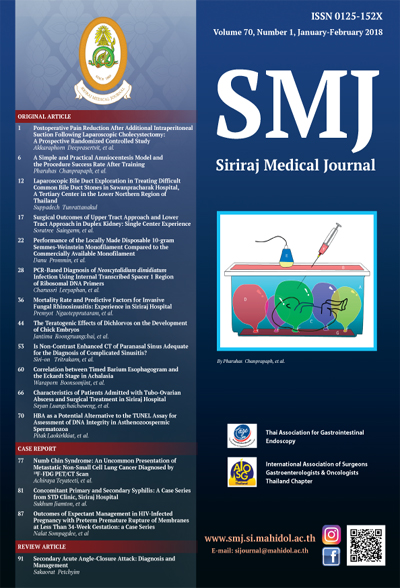Outcomes of Expectant Management in HIV-Infected Pregnancy with Preterm Premature Rupture of Membranes at Less Than 34-Week Gestation: A Case Series
Keywords:
Expectant management; HIV; preterm premature ruptured of membranes; vertical transmissionAbstract
Objective: To present outcomes of expectant management (EM) in HIV-infected pregnancy with preterm premature rupture of membranes (PPROM) at less than 34-week gestation.
Case presentation: During January 2008-December 2015, there were 513 HIV-infected pregnant women giving birth at Siriraj Hospital, Thailand. Ten of them presented with PPROM at GA <34 weeks and six women received EM. The deliveries took place at GA 28 2/7 - 33 5/7 weeks. The longest interval of ROM was 15 days and the highest on-admission viral load was 633,000 copies/mL. Three of them had antepartum highly active antiretroviral therapy (HAART) for at least four weeks prior to the delivery. Mode of delivery included 3 vaginal deliveries and 3 caesarean sections. All infants’ HIV molecular tests were negative at birth. The longest follow-up interval was 12 months and HIV vertical transmission remained negative.
Conclusion: Expectant management in HIV-infected women with PPROM at GA <34 weeks may be sensible because complications of prematurity outweigh the risk of vertical HIV transmission.
Downloads
Published
How to Cite
Issue
Section
License
Authors who publish with this journal agree to the following conditions:
Copyright Transfer
In submitting a manuscript, the authors acknowledge that the work will become the copyrighted property of Siriraj Medical Journal upon publication.
License
Articles are licensed under a Creative Commons Attribution-NonCommercial-NoDerivatives 4.0 International License (CC BY-NC-ND 4.0). This license allows for the sharing of the work for non-commercial purposes with proper attribution to the authors and the journal. However, it does not permit modifications or the creation of derivative works.
Sharing and Access
Authors are encouraged to share their article on their personal or institutional websites and through other non-commercial platforms. Doing so can increase readership and citations.











